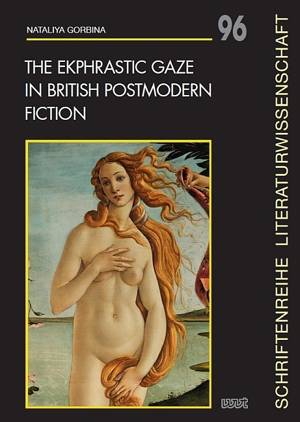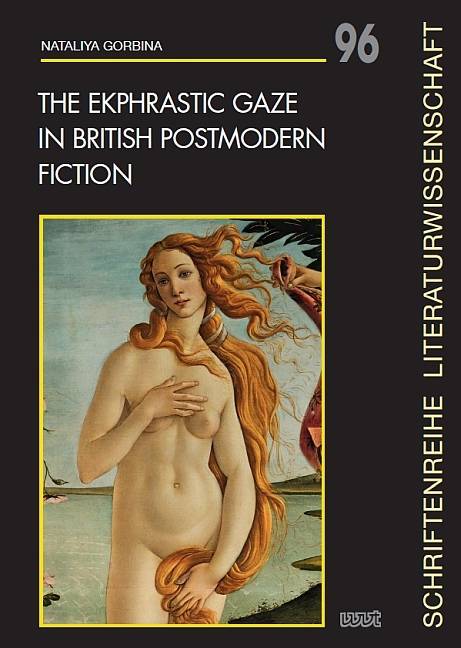
- Retrait gratuit dans votre magasin Club
- 7.000.000 titres dans notre catalogue
- Payer en toute sécurité
- Toujours un magasin près de chez vous
- Retrait gratuit dans votre magasin Club
- 7.000.000 titres dans notre catalogue
- Payer en toute sécurité
- Toujours un magasin près de chez vous
Description
From the appreciation of female beauty as Botticellian to the acknowledgement of the Van-Goghian pathos of Provençal landscapes, the ekphrastic gaze of a British postmodern observer offers a socioculturally conditioned vision of artistically/aesthetically modified reality. Looking at over thirty works including Julian Barnes's Metroland (1980), John Fowles's The Magus (1965), and Michael Frayn's Headlong (1999), this book addresses the phenomenon of the 'ekphrastic gaze' and provides a comprehensive survey of its poetics and politics in British postmodern fiction.
Drawing upon a combination of theories and approaches from Literary Studies, Art Studies, Cultural Studies, and the Social Sciences, this study investigates the ways in which the ekphrastic gaze contributes to the (de-/re-)construction of a broad variety of iconographical and iconological meanings within the all-encompassing shift from modernism/modernity towards postmodernism/postmodernity in British fiction. It introduces the concept of the postmodern chronotope of the (pseudo-)connoisseurial quest and the character type of the (Pseudo-)Connoisseur that this chronotope relies on; delineates the functions of the ekphrastic gaze as a deconstructionist reading tool; and, last but not least, sheds light on the meta-ekphrastic interplay between the fictional ekphrastic discourse and the metanarratives of Art History, Art Theory, and Aesthetics through the recycling of socioculturally prevalent and authoritative formulae of artistic/aesthetic perception.
Contents
1. A Postmodern Déjà Vu ................................................................................ 1
2. The Postmodern Turn Through the Ekphrastic Gaze ................................. 17
3. In the Interstices between Art, Words, and Life ........................................ 33
3.1 "Could a Life be a Work of Art"? ............................................................. 33
3.2 The Compositional Fabrication of Ekphrastic Reality ............................... 43
3.3 The Iconography and the Iconology of Ekphrastic Reality........................ 53
3.3.1 The Ekphrastic Gaze and the Third Dimension of a Work of Art:
From the Removal of Three Centuries of Dirt
to the Revelation of a Gainsboroughesque Dream ........................... 58
3.3.2 The Ekphrastic Gaze and the 'Docile Body':
From the Antichrist's Michelangelesque Curls
to Erato's Rokeby Venus Pose ......................................................... 68
3.4 Conclusion ................................................................................................. 81
4. In the Interstices between the Gazes of Author, Character, and Reader .... 83
4.1 Who Was the Ekphrastic Beholder After All? ........................................... 83
4.2 The Dialectic of the Ekphrastic Beholder
as the (Pseudo-)Connoisseur ..................................................................... 89
4.2.1 Through the (Pseudo-)'Intellectual Lens' of the
Ekphrastic Beholder's Gaze: The 'Bloody Ruskin'
of British Postmodern Fiction .......................................................... 93
4.2.2 On the (Pseudo-)'Moral Retina' of the
Ekphrastic Beholder's Gaze: The 'Con-Turned-Artist'
of British Postmodern Fiction ........................................................ 104
4.3 The Interplay between the Ekphrastic Gazes of Author,
Character, and Reader ............................................................................. 113
4.3.1 Following in the Footsteps of Author and Character:
The 'Scholarly' and 'Alert' Mock Reader of
British Postmodern Fiction ........................................................... 116
4.3.2 The Real Reader's Ekp
Drawing upon a combination of theories and approaches from Literary Studies, Art Studies, Cultural Studies, and the Social Sciences, this study investigates the ways in which the ekphrastic gaze contributes to the (de-/re-)construction of a broad variety of iconographical and iconological meanings within the all-encompassing shift from modernism/modernity towards postmodernism/postmodernity in British fiction. It introduces the concept of the postmodern chronotope of the (pseudo-)connoisseurial quest and the character type of the (Pseudo-)Connoisseur that this chronotope relies on; delineates the functions of the ekphrastic gaze as a deconstructionist reading tool; and, last but not least, sheds light on the meta-ekphrastic interplay between the fictional ekphrastic discourse and the metanarratives of Art History, Art Theory, and Aesthetics through the recycling of socioculturally prevalent and authoritative formulae of artistic/aesthetic perception.
Contents
1. A Postmodern Déjà Vu ................................................................................ 1
2. The Postmodern Turn Through the Ekphrastic Gaze ................................. 17
3. In the Interstices between Art, Words, and Life ........................................ 33
3.1 "Could a Life be a Work of Art"? ............................................................. 33
3.2 The Compositional Fabrication of Ekphrastic Reality ............................... 43
3.3 The Iconography and the Iconology of Ekphrastic Reality........................ 53
3.3.1 The Ekphrastic Gaze and the Third Dimension of a Work of Art:
From the Removal of Three Centuries of Dirt
to the Revelation of a Gainsboroughesque Dream ........................... 58
3.3.2 The Ekphrastic Gaze and the 'Docile Body':
From the Antichrist's Michelangelesque Curls
to Erato's Rokeby Venus Pose ......................................................... 68
3.4 Conclusion ................................................................................................. 81
4. In the Interstices between the Gazes of Author, Character, and Reader .... 83
4.1 Who Was the Ekphrastic Beholder After All? ........................................... 83
4.2 The Dialectic of the Ekphrastic Beholder
as the (Pseudo-)Connoisseur ..................................................................... 89
4.2.1 Through the (Pseudo-)'Intellectual Lens' of the
Ekphrastic Beholder's Gaze: The 'Bloody Ruskin'
of British Postmodern Fiction .......................................................... 93
4.2.2 On the (Pseudo-)'Moral Retina' of the
Ekphrastic Beholder's Gaze: The 'Con-Turned-Artist'
of British Postmodern Fiction ........................................................ 104
4.3 The Interplay between the Ekphrastic Gazes of Author,
Character, and Reader ............................................................................. 113
4.3.1 Following in the Footsteps of Author and Character:
The 'Scholarly' and 'Alert' Mock Reader of
British Postmodern Fiction ........................................................... 116
4.3.2 The Real Reader's Ekp
Spécifications
Parties prenantes
- Auteur(s) :
- Editeur:
Contenu
- Nombre de pages :
- 192
- Langue:
- Anglais
- Collection :
- Tome:
- n° 96
Caractéristiques
- EAN:
- 9783868219227
- Date de parution :
- 20-10-21
- Format:
- Livre broché
- Dimensions :
- 155 mm x 14 mm
- Poids :
- 361 g







